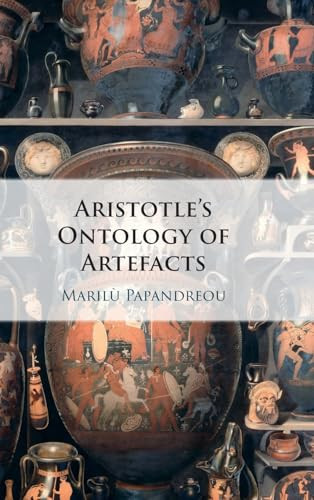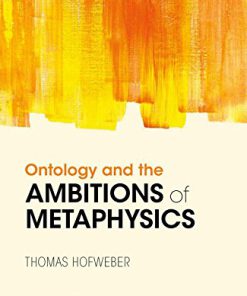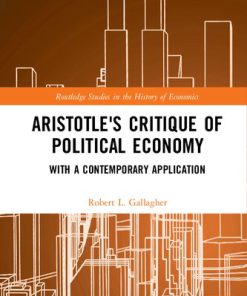Aristotle s Ontology of Artefacts 1st Edition by Marilù Papandreou ISBN 1009340506 978-1009340502
$50.00 Original price was: $50.00.$25.00Current price is: $25.00.
Aristotle’s Ontology of Artefacts 1st Edition by Marilù Papandreou – Ebook PDF Instant Download/Delivery: 1009340506, 978-1009340502
Full download Aristotle’s Ontology of Artefacts 1st Edition after payment

Product details:
ISBN 10: 1009340506
ISBN 13: 978-1009340502
Author: Marilù Papandreou
It is commonly believed that Aristotle merely uses artefacts as examples or analogical cases. This book, however, shows that Aristotle gives a specific, coherent account of artefacts that in various ways owes much to Plato. Moreover, it proposes a new, definitive solution to the problem of artefacts’ substantiality, which comprises two controversial positions: (i) that Aristotle holds a binary view of substantiality according to which artefacts are not substances at all; (ii) that artefacts fail to be substances because they exhibit less of a unity than natural wholes. Finally, responding to the contemporary debate on ordinary objects, the book identifies the main propositions for an ontology of artefacts that aspires to use Aristotle as its authority and can serve as a guideline for current metaphysical discussions. This title is part of the Flip it Open Programme and may also be available Open Access. Check our website Cambridge Core for details.
Table of contents:
Introduction
0.1 Artefacts in the Contemporary Debate
0.2 Artefacts in Aristotle: Some Preliminary Observations
0.3 Aristotelian Scholarship: The Status Quaestionis
0.4 A Piecemeal Approach
0.5 Aristotle’s Ontology of Artefacts
Chapter 1 The Platonic Heritage
1.1 Plato’s Metaphysics of Artefacts
1.1.1 Plato’s Ideas of Artefacts in the Cratylus and Republic X
1.1.2 The Doubts of the Young Socrates in the Parmenides
1.1.3 Divine Craftsmanship in the Timaeus
1.2 Building on Plato’s Theoretical Shortcomings
1.2.1 Final Causation
1.2.2 Models, Likenesses and the Notion of Imitation
1.3 Platonic Intuitions as the Source of Aristotle’s Account of Artefacts
1.3.1 Ideas and Forms
1.3.2 Axiology and Metaphysics
1.3.3 Carving Nature at the Joints
1.3.4 Parts and Whole
Chapter 2 Using Artefacts against Plato
2.1 The Arguments
2.1.1 Against the Arguments from the Sciences
2.1.2 The Threat of Aporia
2.1.3 The Logical or Semantic Argument
2.1.4 Aristotle’s Argument from Evidence
2.2 The Notion of Separation
2.3 Aristotle’s Dialectical Use of Artefacts
Chapter 3 Aristotle’s Building Blocks in the Physics
3.1 The Theory of the Four Causes and the Art Analogy
3.2 The Salient Difference between Artefacts and Natural Beings
3.2.1 The Definition of Nature in Phys. 2.1
3.2.2 Daedalus’ Statues, Machines, the Olive Tree and the Swallow’s Nest
3.3 Artefacts Will Typically Come-to-Be by Art
3.3.1 Art as Principle
3.3.2 Other Dependent Objects46
3.4 Some Artefacts Will Only Come-to-Be by Art and Some Natural Beings Will Also Come-to-Be by Art
3.4.1 Inadvertently Made Objects
3.4.2 The Case of Artificial Mixtures
Chapter 4 Artefacts as Hylomorphic Compounds
4.1 Artefacts Undergo Unqualified Coming-to-Be
4.1.1 Intrinsic Change in the Matter
4.1.2 Per Se Unities
4.1.3 Nature-Facts and Found-Objects: The Paperweight and the Strigil
4.2 It’s Not Bronze, It’s a Brazen Statue
4.2.1 The Eikeininon Rule
4.2.2 Actuality-Inducing Action as the Relevant Change in Matter
4.3 Synonymy Principle
4.3.1 The Synonymy Principle Applied to Artefacts
4.3.2 The Form in the Mind of the Artisan as the Form of the Object in Thought and as in Actuality
4.3.3 The Form in the Object in Potentiality: The Artisans’ Tools
4.4 Neither Just Matter nor Accidental Beings
Chapter 5 Forms of Artefacts as Inert and Intermittent
5.1 Art as the Form in the Mind of the Artisan
5.1.1 Art as Efficient Cause of Qualified Coming-to-Be
5.1.2 Art as Efficient Cause of Unqualified Coming-to-Be
5.2 Against Transmission Theory: How the Form in the Object Is Not an Efficient Cause Explained through Biology
5.2.1 On the Difference between the Semen and the Tools
5.2.2 Heartless Artefacts
5.3 Autonomy, Life and Substantiality
5.4 Eternity and Substantiality
Chapter 6 The Relation between Matter and Form in Artefacts
6.1 Artefact-Kinds as Functions
6.2 Diachronic and Synchronic Matter
6.2.1 Remote and Proximate Matter
6.2.2 The Proximate Matter of Artefacts: The Many-to-Many Relationship
6.2.3 The Sources of Hindrances in the Remote Matter of Artefacts
6.3 The Synchronic Matter of Artefacts: Functional Matter and the Homonymy Principle
6.4 What Then? Persisting Matter
6.5 The Unity of Matter and Form and Substantiality
Chapter 7 The Relation Between Parts and Whole in Artefacts
7.1 How to Explain What a Thing Is: The Differentiae in H 2
7.2 The Static Picture
7.2.1 Unity by Contact
7.2.2 Unity by Continuity
7.2.3 Unity by Wholeness
7.3 Unity and the Substantiality of Artefacts
7.3.1 Having a Form, but with Parts in Actuality
7.3.2 Failing Met. Z 13’s Substantiality Criterion
7.3.3 Hylomorphism and Substantiality Diverge
7.3.4 Unqualified Coming-to-Be Reconsidered: Production and Destruction
Chapter 8 The Physics and Metaphysics of Artefacts
8.1 The Dynamic Picture: Maintenance and Performance
8.2 Back to the Physics?
8.3 Artefacts as Objects of Inquiry
8.3.1 The Physicist, the Artisan and the User
8.3.2 The Metaphysician
8.3.3 The Cheap Coppersmith and the Spit-and-Lampstand
People also search for:
aristotle’s ontology of artefacts
what is aristotle’s epistemology
aristotle is famous for
aristotle’s ontology
aristotelian ontology meaning
Tags: Marilù Papandreou, Aristotle, Ontology, Artefacts
You may also like…
Politics & Philosophy - Anthropology
Aristotle s Revenge The Metaphysical Foundations of Physical and Biological Science Edward Feser
Politics & Philosophy - Anthropology
Ontology and the ambitions of metaphysics 1st Edition Hofweber
Politics & Philosophy - Anthropology
Schelling s Ontology of Powers 1st Edition Charlotte Alderwick
Politics & Philosophy
Politics & Philosophy
Politics & Philosophy - Anthropology
Politics & Philosophy
Philosophy Obligation and the Law Bentham s Ontology of Normativity 1st Edition Piero Tarantino
Business & Economics
Hegel s Ontology Of Power The Structure Of Social Domination In Capitalism Arash Abazari
Business & Economics












